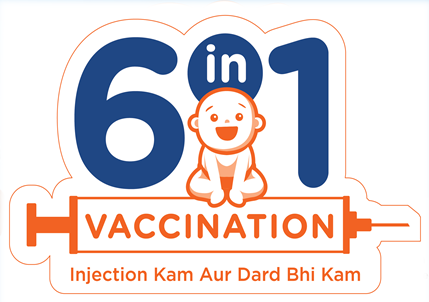

You are now leaving GSK’s website and are going to a website that is not operated/controlled by GSK. Though we feel it could be useful to you,we are not responsible for the content/service or availability of linked sites. You are therefore mindful of these risks and have decided to go ahead.
Agree Agree Agree Stay
How vaccinations could protect against infections
Children have a developing immune system and are given multiple vaccinations in their early years of life. Vaccination mimics infections caused by bacteria or viruses. In response, the child’s immune system produces antibodies or specialized immune cells that can help the body get rid of the intruders if the growing child is exposed to the same bacteria or viruses later in life.1
There are multiple infectious diseases against which a baby needs protection from during infancy and childhood.2 Almost all of these are given via an injection. Most parents do not want their little ones to experience pain from multiple injections. Today, however, advances in science and technology have led to the development of combination vaccination, like 6 in 1 vaccination, which combines multiple vaccinations in one shot. Fewer shots mean less pain but with the same level of protection as the individual shots.3
How 6 in 1 vaccination benefits children
As the name suggests, 6 in 1 vaccination refers to a single vaccination that protects a child against six serious diseases: diphtheria, whooping cough (pertussis), hepatitis B, Hib disease (Haemophilus influenzae type b disease), polio, and tetanus.4 Here is why this protection can be so crucial:
1. Polio
Polio is caused by a virus and often affects children under five years of age. There is no treatment for Polio and it can lead to permanent disabilities, paralysis, and even death. Polio can be prevented with vaccination; good sanitation and proper hygiene are also important.5
2. Pertussis
Also known as whooping cough, pertussis is a respiratory disease that can be very serious for infants and small babies. Pertussis is contagious and can cause complications and difficulty breathing. The virus can spread from one person to the other through infectious droplets. Vaccination is an important strategy to prevent this disease.6
3. Diphtheria
Diphtheria is a serious bacterial infection that primarily affects the nose and throat. It can cause serious complications such as breathing difficulties, lung infection, heart damage, and paralysis. Diphtheria can be prevented by isolating from the infected person and vaccination.7
4. Hib disease (Haemophilus influenzae type b disease)
Hib disease is a bacterial infection that can cause mild infection or more serious diseases such as pneumonia and meningitis. It largely affects children under five years of age. Hib can be prevented by maintaining good sanitation, proper hygiene, and vaccination.8
5. Hepatitis B
Hepatitis B is caused by a virus that affects the liver. The virus can cause a mild short-term illness in the child or a long-term infection that can lead to significant liver damage later in life. A child can get the virus from his/her mother at the time of birth. Hepatitis B can be prevented by avoiding blood & bodily fluid contact with infected person, good sanitation, and vaccination.9
6. Tetanus
Tetanus is a bacterial disease that causes muscle stiffness, spasms, and even death. The bacterial spores are commonly found in dust and soil and can enter the body through breaks in the skin. Tetanus can be prevented by wound care & maintenance and vaccination.10
Side effects from 6 in 1 vaccination are similar to those of individual vaccinations. The swelling or pain at the injection site may be slightly more with combination vaccination, though it would still be less than the pain of administering multiple injections. Other side effects include fever, irritability, and loss of appetite, which are common to most other vaccinations.4
Commenting about the benefits of combination vaccination, Dr Manish Gour, Consulting Pediatrician and Director Pranaam Hospitals Pvt. Ltd. Hyderabad, said, “Combination vaccinations are beneficial in many ways. First and foremost, the child gets fewer pricks, which reduces the amount of pain that he/she would otherwise have to endure. When a child has to take multiple injections, the parents sometimes want to spare their child the pain and so they do not take all the vaccinations at the same time. But that increases the likelihood of the parent forgetting to return for the vaccinations that are left or missing the age slot during which the vaccinations can be given. Combination vaccinations reduce the number of visits to the doctor and improve compliance.”
Recommended Schedule for 6 in 1 Vaccination Aligned to the schedule recommended by the Indian Academy of pediatrics (IAP), the DTP-IPV-Hib-HepB should be given to babies at the age of 6, 10 and 14 weeks. 6-in-1 vaccination provides protection for these 6 diseases.11
If your baby has missed routine vaccination or for additional information on the subject and any medical advice, talk to your Paediatrician.
For more information on the diseases, modes of prevention including vaccination, click here.
References:
